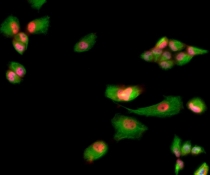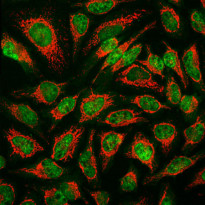ARG10721
anti-MBNL1 antibody [1H1]
anti-MBNL1 antibody [1H1] for ICC/IF,IHC-Frozen sections,Western blot and Human
概述
| 产品描述 | Mouse Monoclonal antibody [1H1] recognizes MBNL1 |
|---|---|
| 反应物种 | Hu |
| 预测物种 | Chk |
| 不反应物种 | Ms, Rat |
| 应用 | ICC/IF, IHC-Fr, WB |
| 宿主 | Mouse |
| 克隆 | Monoclonal |
| 克隆号 | 1H1 |
| 同位型 | IgG1 |
| 靶点名称 | MBNL1 |
| 抗原物种 | Human |
| 抗原 | Full-length recombinant Human MBNL1. |
| 偶联标记 | Un-conjugated |
| 別名 | Muscleblind-like protein 1; Triplet-expansion RNA-binding protein; MBNL; EXP |
应用说明
| 应用建议 |
|
||||||||
|---|---|---|---|---|---|---|---|---|---|
| 应用说明 | * The dilutions indicate recommended starting dilutions and the optimal dilutions or concentrations should be determined by the scientist. |
属性
| 形式 | Liquid |
|---|---|
| 纯化 | Affinity purification. |
| 缓冲液 | PBS and 50% Glycerol. |
| 稳定剂 | 50% Glycerol |
| 浓度 | 1 mg/ml |
| 存放说明 | For continuous use, store undiluted antibody at 2-8°C for up to a week. For long-term storage, aliquot and store at -20°C. Storage in frost free freezers is not recommended. Avoid repeated freeze/thaw cycles. Suggest spin the vial prior to opening. The antibody solution should be gently mixed before use. |
| 注意事项 | For laboratory research only, not for drug, diagnostic or other use. |
生物信息
| 数据库连接 | |
|---|---|
| 基因名称 | MBNL1 |
| 全名 | muscleblind-like splicing regulator 1 |
| 背景介绍 | This gene encodes a member of the muscleblind protein family which was initially described in Drosophila melanogaster. The encoded protein is a C3H-type zinc finger protein that modulates alternative splicing of pre-mRNAs. Muscleblind proteins bind specifically to expanded dsCUG RNA but not to normal size CUG repeats and may thereby play a role in the pathophysiology of myotonic dystrophy. Mice lacking this gene exhibited muscle abnormalities and cataracts. Several alternatively spliced transcript variants have been described but the full-length natures of only some have been determined. The different isoforms are thought to have different binding specificities and/or splicing activities. [provided by RefSeq, Sep 2015] |
| 生物功能 | Mediates pre-mRNA alternative splicing regulation. Acts either as activator or repressor of splicing on specific pre-mRNA targets. Inhibits cardiac troponin-T (TNNT2) pre-mRNA exon inclusion but induces insulin receptor (IR) pre-mRNA exon inclusion in muscle. Antagonizes the alternative splicing activity pattern of CELF proteins. Regulates the TNNT2 exon 5 skipping through competition with U2AF2. Inhibits the formation of the spliceosome A complex on intron 4 of TNNT2 pre-mRNA. Binds to the stem-loop structure within the polypyrimidine tract of TNNT2 intron 4 during spliceosome assembly. Binds to the 5'-YGCU(U/G)Y-3'consensus sequence. Binds to the IR RNA. Binds to expanded CUG repeat RNA, which folds into a hairpin structure containing GC base pairs and bulged, unpaired U residues. [UniProt] |
| 预测分子量 | 42 kDa |
检测图片 (4) Click the Picture to Zoom In
-
ARG10721 anti-MBNL1 antibody [1H1] ICC/IF image
Immunocytochemistry: HeLa cells were stained with ARG10721 anti-MBNL1 antibody [1H1] at 1: 1000. Muscleblind-like protein 1 is present in the nucleus of HeLa cells (red). Co-staining is with a rabbit polyclonal antibody against vimentin (red) reveals cytoplasmic intermediate filaments. Blue is a DNA stain which largely colocalizes with the MBNL1 protein in the nucleus.
-
ARG10721 anti-MBNL1 antibody [1H1] ICC/IF image
Immunofluorescence: HeLa cells stained with ARG10721 anti-MBNL1 antibody [1H1] (green) at 1:1000 dilution and costained with ARG10757 anti-Hsp 60 antibody (red) at 1:5000 dilution.
The MBNL1 antibody specifically labels nuclei, while the Hsp 60 antibody reveals protein expressed in mitochondria.
-
ARG10721 anti-MBNL1 antibody [1H1] WB image
Western blot: HL60 cell lysate was stained with ARG10721 anti-MBNL1 antibody [1H1] at 1:1000 dilution.
-
ARG10721 anti-MBNL1 antibody [1H1] WB image
Western blot: HEK293 (cytosol), HEK293 (nuclear), NIH/3T3 (cytosol), NIH/3T3 (nuclear), HeLa (cytosol) and HeLa (nuclear). The blots were stained with ARG10721 anti-MBNL1 antibody [1H1] (green) at 1:1000 dilution.
MBNL1 protein is predominantly detected in the nuclear enriched fractions. This antibody binds to the Human protein and does not bind the rodent homologue.









